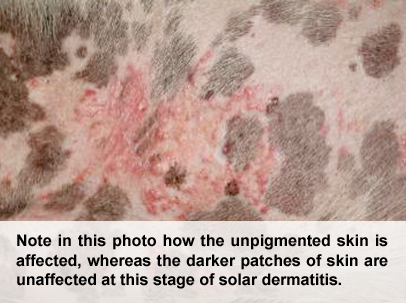Our new website is up!
Can I say, finally?
If you are reading this newsletter online you have found our new website. It has taken a few months but we are excited about the new look and hope that you find it fun and useful for you and your pet.
A new feature of the site is the ability to submit your email address so that Derm Digest will be delivered directly to you. Please feel free to forward our newsletter to your friends and family or direct them to
www.animaldermatology.com if they would like to sign up. While you’re at it, sign up to follow us on Twitter. Animal Dermatology Clinic Facebook accounts are available for geographic areas. Come join the one that is nearest you: Indiana, Kentucky, Georgia, Los Angeles County, Orange County (includes Riverside County) and San Diego County.
If your pet has been treated at Animal Dermatology Clinic, we would like our see your special pet posted in our gallery. Email your digital file of your pet to
newsletter@adcmg.com and we will add it to the gallery for all to see. Include the name of your pet and your town.
The newsletter will grow and evolve with the content that you want to read, so if there is an animal dermatology topic you would like to see covered in upcoming issues, we welcome your suggestions. Email
newsletter@adcmg.com with the subject line of “Topics.”
In the meantime, please enjoy this premiere issue of Derm Digest and we’ll do our best to keep you coming back to read what is going on at Animal Dermatology Clinic.
Indianapolis our newest location
Indiana in the house!

Our newest Animal Dermatology Clinic is located in the Clearwater Shoppes, near Keystone at the Crossing, in Indianapolis, Indiana. Dr. Lori Thompson, ACVD (pictured) heads the clinic and staff. Dr. Thompson has lived in Indiana for 35 years and has been a licensed veterinarian since 2000. She became a boarded dermatologist in 2005 after completing her residency in veterinary dermatology. “I am very happy to be a part of the Animal Dermatology Clinic family. Building our Indianapolis location has been so fun and exciting.” says Dr. Thompson. “I have worked with many of the veterinarians in Indiana throughout my career and I hope that they know that they are always welcome to call me with any questions regarding their dermatology cases…or even to just say hello!”
Animal Dermatology Clinic, Indianapolis
The problem with cats is that they get the exact same look on their face whether they see a moth or an axe-murderer.
~Paula Poundstone
Hot Summer Days are Here
Pets need sun protection, too.

Most of us can’t wait until the long days of summer arrive. It draws us outdoors to soak in those rays of sunshine and though we are constantly reminded to use a sunblock for our skin, some pets are adversely affected by excessive direct sunlight as well.
Solar dermatitis is a condition which affects both our canine and feline friends. Cats are usually affected in the face and ears and white cats or cats with white are areas on the face are commonly affected. The condition is characterized by redness and fine scale on the edges of the ears or other white haired areas with the lesions becoming more severe as time progresses. A preliminary diagnosis is made by a physical examination, history and the classic clinical changes.
A skin biopsy will confirm the diagnosis. Strict sun avoidance is important to prevent further damage however once damage occurs, it is often progressive and leads to more severe skin changes including skin cancer with squamous cell carcinoma the most common for of skin cancer that develops. Laser or surgical removal of the damaged or cancerous tissue is generally curative. Although in some cases if left too long the cancerous tissue involves such an extensive amount of tissue that complete surgical resection is not possible in which case chemotherapy may be necessary. Solar dermatitis of dogs is similar in that it affects short coated white dogs or the undersurface of dogs that are allowed to “sunbathe”. Breeds that have white variants such as Pit Bulls, Bulldogs, Bull Terriers, Boxers and Dalmatians are most at risk. These breeds should not be allowed to have unfettered access to the outdoors. The clinical signs often start with mild redness to the unprotected areas that progress to more severe changes. The areas are often itchy just as sunburns are in humans. Many of these cases are mistakenly thought to be allergies until the condition progresses to the point that chronic actinic (sun) damage and squamous cell carcinoma develop. Similar surgical removal and possible chemotherapy is indicated as in cats for the condition when it develops these changes.

Pets are at less risk by sunbathing by a closed window because glass filters most of the damaging ultraviolet (UV) radiation but open windows or doors should be avoided and unfiltered sunlight coming through an open door or window and reflecting off a floor or other reflective surface also needs to be avoided. Sun blockers with SPFs of at least 50 can be used for limited sun exposure but they are most effective when applied 15 minutes before sun exposure. Special solar protectant clothing should be used when sun exposure is unavaoidable.
Nasal Solar Dermatitis affects dogs and the damaging effects of ultraviolet light on light-colored skin. Skin damage severity depends on the length of exposure and the sun’s intensity with higher elevations experiencing more intense sunlight. Remember that the sun’s rays are most intense between 9AM and 3PM.
Dogs born without pigment in their noses are at the greatest risk for nasal solar dermatitis. If the condition has been diagnosed, early intense protection from the sun is important to prevent further damage. Healing of affected skin results in scar tissue and further damage will enlarge the affected areas and severe damage can lead to permanent crack and fissures that bleed easily.
Source: David A. Duclos, Canine & Feline Skin Diseases and Dr. Rusty Muse, Animal Derm Clinic-Tustin
 “ADC has been like a second family to me. I've been here for almost half my life through the births of my 2 boys until just recently the graduation of my oldest and the support has been wonderful. I love our doctors and staff, and my belief in their work has kept me here all these years – the quality of medicine and care everyone provides is remarkable. It is so rewarding when we have made a difference in the life of our four- legged fur people. Although we would prefer not to have 'regulars' ( we would love to cure them all) it's fun seeing the morning schedule and knowing Molly is coming in to give you a big slobbery kiss, or that Freddie will wiggle his near tailless rear in a hello- oh not to mention their human companions are pretty special too. The rewards of unconditional affection from our patients makes being at work not feel like work!”
“ADC has been like a second family to me. I've been here for almost half my life through the births of my 2 boys until just recently the graduation of my oldest and the support has been wonderful. I love our doctors and staff, and my belief in their work has kept me here all these years – the quality of medicine and care everyone provides is remarkable. It is so rewarding when we have made a difference in the life of our four- legged fur people. Although we would prefer not to have 'regulars' ( we would love to cure them all) it's fun seeing the morning schedule and knowing Molly is coming in to give you a big slobbery kiss, or that Freddie will wiggle his near tailless rear in a hello- oh not to mention their human companions are pretty special too. The rewards of unconditional affection from our patients makes being at work not feel like work!” Did you know?
Did you know?
 Our newest Animal Dermatology Clinic is located in the Clearwater Shoppes, near Keystone at the Crossing, in Indianapolis, Indiana. Dr. Lori Thompson, ACVD (pictured) heads the clinic and staff. Dr. Thompson has lived in Indiana for 35 years and has been a licensed veterinarian since 2000. She became a boarded dermatologist in 2005 after completing her residency in veterinary dermatology. “I am very happy to be a part of the Animal Dermatology Clinic family. Building our Indianapolis location has been so fun and exciting.” says Dr. Thompson. “I have worked with many of the veterinarians in Indiana throughout my career and I hope that they know that they are always welcome to call me with any questions regarding their dermatology cases…or even to just say hello!”
Our newest Animal Dermatology Clinic is located in the Clearwater Shoppes, near Keystone at the Crossing, in Indianapolis, Indiana. Dr. Lori Thompson, ACVD (pictured) heads the clinic and staff. Dr. Thompson has lived in Indiana for 35 years and has been a licensed veterinarian since 2000. She became a boarded dermatologist in 2005 after completing her residency in veterinary dermatology. “I am very happy to be a part of the Animal Dermatology Clinic family. Building our Indianapolis location has been so fun and exciting.” says Dr. Thompson. “I have worked with many of the veterinarians in Indiana throughout my career and I hope that they know that they are always welcome to call me with any questions regarding their dermatology cases…or even to just say hello!” Most of us can’t wait until the long days of summer arrive. It draws us outdoors to soak in those rays of sunshine and though we are constantly reminded to use a sunblock for our skin, some pets are adversely affected by excessive direct sunlight as well.
Most of us can’t wait until the long days of summer arrive. It draws us outdoors to soak in those rays of sunshine and though we are constantly reminded to use a sunblock for our skin, some pets are adversely affected by excessive direct sunlight as well.  Pets are at less risk by sunbathing by a closed window because glass filters most of the damaging ultraviolet (UV) radiation but open windows or doors should be avoided and unfiltered sunlight coming through an open door or window and reflecting off a floor or other reflective surface also needs to be avoided. Sun blockers with SPFs of at least 50 can be used for limited sun exposure but they are most effective when applied 15 minutes before sun exposure. Special solar protectant clothing should be used when sun exposure is unavaoidable.
Pets are at less risk by sunbathing by a closed window because glass filters most of the damaging ultraviolet (UV) radiation but open windows or doors should be avoided and unfiltered sunlight coming through an open door or window and reflecting off a floor or other reflective surface also needs to be avoided. Sun blockers with SPFs of at least 50 can be used for limited sun exposure but they are most effective when applied 15 minutes before sun exposure. Special solar protectant clothing should be used when sun exposure is unavaoidable.